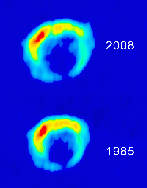A tricky aspect of modern astronomy is keeping all the wavelengths straight. Take the case of G1.9+0.3, a supernova remnant (SNR) near the center of the Milky Way. If you look at an X-ray image of this object made with the Chandra satellite in 2007, you’ll see clear signs of growth compared to what the Very Large Array saw in 1985. But the VLA was working at radio wavelengths, making the image comparison problematic. Scientists studying G1.9+0.3 therefore went back to the VLA to observe the object for a second time in order to verify their initial impression.

The later study confirmed that this supernova remnant — consisting of the materials ejected by the vast explosion — really is growing at what seems to be an unprecedented pace. Fifteen percent growth in 23 years is no small matter in astronomical terms, and the growth also makes it possible to work backwards in time to arrive at the time the supernova went off, now pegged at 150 years ago. That makes G1.9+0.3 the youngest of the 250 known supernova remnants in the Milky Way.
Image: The growth of supernova remnant G1.9+0.3 is clearly visible in this comparison shot. The colour scheme (dark blue -> light blue -> green -> yellow -> red) is increasing radio intensity. The width of each of the above images is about 3 arcmin, i.e. 1/20th of a degree. Credit: VLA/Dave Green.
Intriguingly, this SNR holds one other distinction: Its brightness at radio wavelengths has been increasing over the last few decades, a process unique among galactic supernova remnants. We’ll learn much from future observations. Says Dave Green (University of Cambridge):
“The discovery that G1.9+0.3 is so young is very exciting. It fits into a large gap in the known ages of supernova remnants, and since it is expanding so quickly, we will be able to follow its evolution over the coming years.”
Those observations will continue to be made at X-ray and radio wavelengths for now, the object being obscured by gas and dust so that it is not otherwise visible. Nor would the supernova that created it have been detectable to Victorian astronomers, buried behind dust lanes whose nature and location they did not yet suspect. The paper, accepted by Monthly Notices of the Royal Astronomical Society, is Green, Reynolds et al., “The radio expansion and brightening of the very young supernova remnant G1.9+0.3” (abstract).


A supernova is thought to occur in our galaxy about once a century and before this news, the most recent known was about 400 years old. It was therefore argued that the remnants of more recent supernovas exist, but were not easily visible due to obscuration. This remnant therefore may be the most recent in our Milky Way.
I read at another site this particular remnant resembles the Firefox browser symbol.
I guess there was a call-in show where this event was the subject of discussion, but was shutdown because bigger crackpots than me was spoiling the show.
I guess the gist of it was that the supernova was an astroengineering event.
I guess a supernova could be, but there are more spectacular, non-destructive events I would consider first.
Detective astronomers unearth hidden celestial gem
10 June 2008
ESA’s orbiting X-ray observatory XMM-Newton has re-discovered
an ignored celestial gem. The object in question is one of the
youngest and brightest supernova remnants in the Milky Way,
the corpse of a star that exploded around 1,000 years ago.
http://www.esa.int/esaCP/SEM1OPUG3HF_index_0.html
A 20 Year Radio Light Curve for the Young Supernova Remnant G1.9+0.3
Authors: T. Murphy (1), B. M. Gaensler (1), S. Chatterjee (1) ((1) The University of Sydney)
(Submitted on 11 Jun 2008)
Abstract: The radio source G1.9+0.3 has recently been identified as the youngest known Galactic supernova remnant, with a putative age of ~100 years.
We present a radio light curve for G1.9+0.3 based on 25 epochs of observation with the Molonglo Observatory Synthesis Telescope, spanning 20 years from 1988 to 2007. These observations are all at the same frequency (843 MHz) and comparable resolutions (43″ x 91″ or 43″ x 95″) and cover one fifth of the estimated lifetime of the supernova remnant.
We find that the flux density has increased at a rate of 1.22 +0.24/-0.16 per cent per year over the last two decades, suggesting that G1.9+0.3 is undergoing a period of magnetic field amplification.
Comments: 5 pages, 4 figures, to be published in MNRAS Letters
Subjects: Astrophysics (astro-ph)
Cite as: arXiv:0806.1952v1 [astro-ph]
Submission history
From: Tara Murphy [view email]
[v1] Wed, 11 Jun 2008 20:01:20 GMT (298kb)
http://arxiv.org/abs/0806.1952